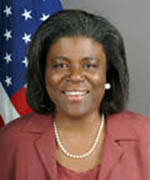Amb. Linda Thomas-Greenfield, the Director General, visited Savannah earlier this month to discuss the Foreign Service, including advice for applicants. Thomas-Greenfield has spent most of her career living and working in Africa. Before returning to Washington, DC, she served as Ambassador to Liberia. An open and straightforward diplomat, her career did not follow a traditional route to the top job in the Foreign Service.
Indeed, Thomas-Greenfield spent many years working in the Bureau of Population, Refugees and Migration, including a tour as the Regional Refugee Officer in Nairobi, covering a number of countries including Kenya, Ethiopia, Somalia, Uganda and the Great Lakes countries. During her tenure, she witnessed the 1994 genocide in Rwanda and helped coordinate U.S. aid efforts to hundreds of thousands of Rwandans who fled the and into the Democratic Republic of the Congo.
Thomas-Greenfield’s career highlights an important point that still holds true in the Foreign Service; namely, there is no one path to make it into the senior ranks. In Linda’s case, she followed one of her passions — humanitarian and refugee issues — and did well, leading to jobs with more responsibility and ultimately the 7th floor of the State Department.
In April, she visited Savannah State University during a recent trip to the southeast. I have summarized the key points of Amb Thomas-Greenfield’s remarks in Georgia:
- in 2012, 22,000 applicants took the Foreign Service Exam, but the State Department hired only 425 FSOs;
- Under Hillary Clinton, the Foreign Service grew 21 percent, reaching an estimated 14,000 diplomats.
Diversity is Essential
During her presentation, Thomas-Greenfield, a 31-year veteran, complained that the Foreign Service needs more diversity, explaining that white men from generally elite eastern universities still dominate the Foreign Service. The Director General said that minorities and women have been underrepresented in what is supposed to be a more open and inclusive U.S. Government.
- The Foreign Service is made up of approximately 5 percent African-Americas, while Hispanics and Asians represent about 4 percent. Women are 40 percent of the Foreign Service. (Remember that up to 1972, women who married were forced to quit the Foreign Service.)
Thomas-Greenfield went on to describe the importance of U.S. diplomats who typically precede the U.S. Armed Forces in any conflict. She spoke about the loss of Amb. Chris Stevens, killed in the September 2012 attack in Benghazi. Underlining the dangers of diplomatic work, Thomas-Greenfield also told the packed crowd that diplomacy is the cutting-edge of U.S. foreign policy and remains critically important. She said that counter-terrorism, human rights and nuclear proliferation are top concerns.
- Thomas-Greenfield also listed the most important attributes for a successful U.S. diplomat — communications skills, especially writing (italics added)

Recent Comments